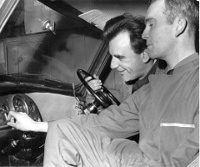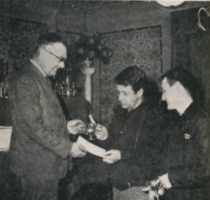THE "EXPRESS AND STAR" -
ANOTHER VICTORY FOR
TONY FISHER/BRIAN MELIA
By Graham Robson
The Express and Star was wonderful—no more need be said, and no further qualification is needed, for this fabulously routed, impeccably organized, but flexibly run rally.

Harry Morgan and Richard Binns had laid out a testing route on the lesser rallied areas of 129, 118, 117, 128 and 127, with 68 manned controls and no tricks at all. The weather had relented at last, and this must be the first championship rally for over three months which has been run on clear roads—not too clear, however, as there was still a liberal coating of gravel on all the hills, and the frost had taken its vicious toll of the road surfaces as well. The effect of greasy gravelly surfaces, sprinkled with potholes, was to produce conditions as prime as any encountered for a very long time, and the number of incidents was indeed very high. Well-deserving winners were Tony Fisher and Brian Melia in the now veteran Cooper, who lost no fewer than 14 mins., followed at a respectable distance by David Seigle-Morris and David Stone in an exhaustless factory Anglia.
There were quite a few amendments to the published programme when the field actually lined up to go. Roy Fidler had borrowed a factory Vitesse instead of his more usual Allardette, while Simister had to effect a sudden change of mount when his old Allardette expired on the way to the start. Peter Astbury was back with a rebuilt Vitesse (after his Cats’ Eyes accident) while David Hiam was driving a Wolseley Hornet (some say it was chauffer driven!).
The complete route details were issued when signing in at the start, and by the time the first control was reached on top of the Long Mynd, every navigator had a nice tidy “office” ready for a good drivers' thrash, which is just what it turned out to be. The first batch of sections were all in the western shadow of the Mynd, and even on the first section there were some surprises (some say that there was road under all that water); at the first control Pauline Mayman and Val Domleo were eliminated when their factory M.G. 1100 shed its sump shield and part of the exhaust system, which became untidily mangled underneath the car. The Broad Shiela Taylor 1100 was already out with failed transmission on the Mynd and by the time Control 5 was reached (after only 15 mins. rallying) on a new white road near New Leasowes all the clean sheets had been dirtied! First really new stuff, needing the use of powerful magnifiers, was in the woods south of Habberley, with a tight 2-minuter causing wholesale loss of time on approach to Snail Beach, then the route dodged back onto 129 for a further dozen controls round the Bog and Old Church Stoke areas. The usual Sprinzel luck struck after 12, when John was forced to change a punctured wheel on a main road section, and of all things, a stone punctured the distributor of Fidler's factory Vitesse, and needed fabrication of cardboard and masking tape before the car was able to show its true capabilities by being clean from here to Control 54.
A short foray onto Map 118 led on to the more familiar battleground of the Welshpool area, and the inclusion of the first “new” road in the shape of a slippy white through 117 157000, closely followed by more tricky stuff just east and south of here. At this point the borrowed Allardette of Phil Simister announced its presence by hurling a useless dynamo into the roadway, and the remaining half hour of the first part of the rally was spent without either battery charge or water circulation. The dynamo was changed at the night halt, with a loss of a further 15 mins. on schedule, and resulted indirectly in this unfortunate crew incurring five fails at the very end of the rally through inability to keep away from the dreaded 30 mins. lateness.
The petrol stop was of only 15 mins. duration, and here at Tregynon the order of arrival was very disjointed. Among the tales of woe was that of Gerald Bloom, who complained that his Cooper had done the entire first half of the rally without a throttle return spring attached. Brian Harper/Ron Crellin retired here with a dynamo which would not produce charge above 4,000 r.p.m. (and as Brian said— who uses less than 4.000 r.p.m. on a Sebring Sprite?).
Another non-arrival was the Standard 10 of Cyril Corbishley, who was reported to have had an accident with a non-competing car. Sprinzel also retired here with non-existent oil pressure on his Anglia, and in general the field which left for the final 34 sections was rather depleted.
The route from Tregynon used well-known stuff for a time, including the well-known “deep ford followed by hairpin right turn" south east of Clatter which collected a Saab as a drowned victim quite early on, and a sizeable block developed before this worthy device could be persuaded to two-stroke again in the correct sequence. A whole batch of 2-min. sections followed, which defeated everyone and these were followed by a well-known “blind brow followed by sharp left at T” which proved too sharp for Sydney Allard's Allardette, which was seen by your correspondent nestling cosily against the nearby telegraph pole for a short time. The same fate overtook Brian Culcheth’s Sprite while the fancied Roger Clark Cooper went out with a sheared drive shaft at this point in the rally. Two longer and easier sections over the Dylife Road to Machynlleth channelled the rally to the next interesting phase near the coast, and here Fidler's Vitesse finally expired with various bothers.
A sharp dash south to Glaspwll, then west to Pont Llyfnant with an approach direction from the N.E. caused some head scratching, for two bits of road are not marked, and even when found the necessary manoeuvres around hairpin junctions were sure to cause further extraction of penalty. Pat Giblett's Healey 3000 looked very unhappy on this stuff, and scuttled away down the road to turn round in a wider area. A new section to many was the long belt up towards the Anglers Retreat, followed by two short sections south and east into the frankly space-fiction territory of bleak moorlands, half-completed dams, scaffolding and rough roads, which turned out to be a piece de resistance over Central Electricity Board land at a higher average speed. For the latter 5-min. section—the road books comment was “Don't sweat—the approach direction is correct (127/762864 N.W.)—the route will be obvious." It was obvious also how impossible it was to maintain the average speeds any more and even Fisher lost more time in the last hour than for the whole of the rest of the

The final half dozen sections lay in country already familiar to those who competed in last year's London Rally, and eventually the final two sections situated south of the main A44 had to be cancelled because they were only just “on" for the early arrivals, and later numbers found that it was impossible to climb the grassy hills, and were unable to reach the controls.
It was a welcome end also for Seigle-Morris whose Anglia shed its exhaust system, as did the veteran Mini of Mike Sutcliffe and others. A scrap metal agent in Goginan would do a roaring trade after this event by going out on to the Dam Road and picking up all the dropped parts!
From Devils Bridge a 90-min. run home led the route back over the old coach road to the special test at the head of the Elan Valley (to sort out the clean sheets—if any) then via the Elan Valley Hotel and Rhayader to the usual finish rendezvous of Llandrindod Wells.
Result calculations were if anything quicker than ever, and each competitor had his own detail results within minutes of handing in all the time cards, and full provisional results were announced by Richard Binns as soon as the last car had arrived.
Naturally, there were no protests, and the only mystery was how it is only the Express and Star organizers who can put on such a wonderful thrash as this, where much of the time there is no public to disturb, and much of the meatier sections are really in the wilds of the mountains. It is my personal opinion that it will not be possible for any other championship rally to approach the standards set by the W.S.S.C.C. for 1963.
